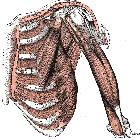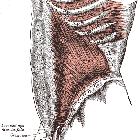Internal intercostal muscle









The internal intercostal muscles are important muscles of respiration. They number eleven on each side and are located in the intercostal spaces, reducing the transverse dimension of the thoracic cavity during expiration.
Gross anatomy
The internal intercostal muscles are the middle muscle of the three intercostal muscles and arise from the costal groove of the rib above. The fibers run in a downwards, backwards and lateral direction (perpendicular to the external intercostal muscles) and insert into the superior border of the rib below. Anteriorly, the lower muscles become continuous with the internal oblique muscles in the anterolateral abdominal wall. As their name indicates, they are internal to the external intercostal muscles.
Blood supply
- arterial supply: anterior and posterior intercostal arteries
- venous drainage: internal thoracic vein and intercostal veins
Innervation
Muscular branches from the intercostal nerves of the respective intercostal space (T1-T11), which run with the intercostal vessels under the costal groove in between the internal and innermost intercostal muscles.
Action
Internal intercostal muscle contraction causes reduction in volume of the thoracic cavity in the transverse dimension, expelling air from the lungs during expiration. They are weaker than the external intercostal muscles.
Siehe auch:
und weiter:

